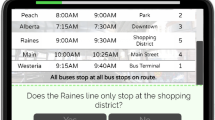Abstract
This paper discusses the design of an explanation facility for answering student-initiated questions. The facility is based on a hybrid planning architecture that models functionally distinct subtasks of explanation planning with mechanisms suited for those tasks. The paper focuses on mechanisms for four of these tasks: selection of knowledge relevant to a query, choice of conceptual model on which to base the explanation, addition of pedagogically motivated material, and coherent ordering. Specific recommendations are made for the design of an ITS capable of providing these functionalities when responding to student initiated queries.
Preview
Unable to display preview. Download preview PDF.
Similar content being viewed by others
References
A. Cawsey: Generating interactive explanations. Proc 9th AAAI. Anaheim, California, 1991.
B. Falkenhainer & K. Forbus: Compositional Modeling: Finding the right model for the job. Artificial Intelligence. 51. 1991.
E. Hovy: Pragmatics and natural language generation. Artificial Intelligence. 43(2), 1991.
J. Lester & P. Porter: A revision-based model of instructional multi-paragraph discourse production. Proc. 13th Cognitive Science. Chicago, 1991.
M. Maybury: Planning multisentential English text using communicative acts. Unpublished doctoral dissertation, Cambridge University, 1991.
K. McCoy: Generating context-sensitive responses to object-related misconceptions. Artificial Intelligence. 41(2), 1989.
K. McKeown, M. Wish & K. Matthews: Tailoring explanations for the user. Proc. 9th IJCAI. Los Angeles, California, 1985.
J. Moore & W. Swartout: A Reactive Approach to Explanation. Proc. 11th IJCAI. Detroit, Michigan, 1989.
T. Murray & B. Woolf: A Knowledge Acquisition Framework for Intelligent Learning Environments. Proc. ITS-92 (this volume).
C. Paris. Combining discourse strategies to generate descriptions to users along a Naive/Expert spectrum. Proc. 10th IJCAI, Milan, Italy, 1987.
E. Rissland (Michener): Understanding understanding mathematics. Cognitive Science. 2(4), 1978.
J. Self: Bypassing the intractable problem of student modeling. Proc. ITS-88. Monteal, 1988.
D. Suthers: Providing multiple views of reasoning for explanation. Proc. ITS-88. Montreal, 1988.
-: A task-appropriate hybrid architecture for explanation. Computational Intelligence. 7(4), 1991.
-: An analysis of explanation and implications for the design of explanation planners. Ph.D. dissertation, University of Massachusetts, Amherst, 1992.
D. Suthers, B. Woolf, & M. Cornell: Steps from explanation planning to model construction dialogues. Proc. 10th AAAI. San Jose, California, 1992.
B. White & J. Frederiksen: Causal model progressions as a foundation for intelligent learning environments. Artificial Intelligence. 42(1), 1990.
I. Zukerman: A predictive approach for the generation of rhetorical devices. Computational Intelligence. 6(1), 1990.
Author information
Authors and Affiliations
Editor information
Rights and permissions
Copyright information
© 1992 Springer-Verlag Berlin Heidelberg
About this paper
Cite this paper
Suthers, D.D. (1992). Answering student queries: Functionality and mechanisms. In: Frasson, C., Gauthier, G., McCalla, G.I. (eds) Intelligent Tutoring Systems. ITS 1992. Lecture Notes in Computer Science, vol 608. Springer, Berlin, Heidelberg. https://doi.org/10.1007/3-540-55606-0_25
Download citation
DOI: https://doi.org/10.1007/3-540-55606-0_25
Published:
Publisher Name: Springer, Berlin, Heidelberg
Print ISBN: 978-3-540-55606-0
Online ISBN: 978-3-540-47254-4
eBook Packages: Springer Book Archive




